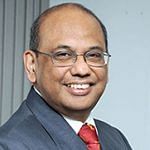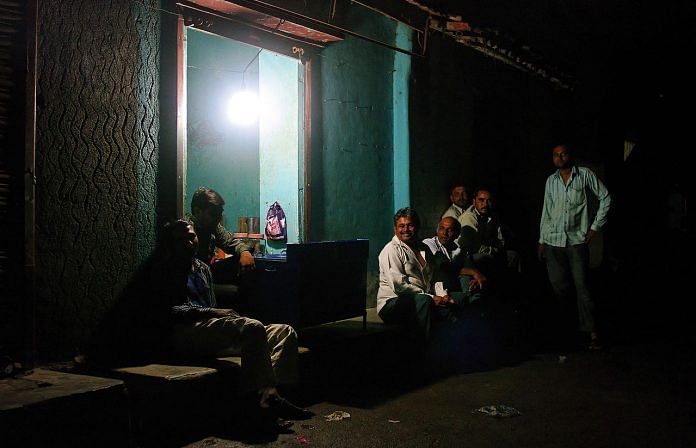Prime Minister Narendra Modi has launched a new scheme called Saubhagya to ensure electrification of all willing households in the country in rural as well as urban areas by 2019. The focus is on last mile connectivity and poor households would be provided electricity connections free of cost.
Is Modi’s new electricity-for-all-homes scheme Saubhagya a realistic goal to achieve, given the health of our state power utilities? We ask experts.
Saubhagya program: The next bold step for electrification – necessary but is it sufficient?
 Rahul Tongia
Rahul Tongia
Fellow, Brookings India
After years of high-level definitions and programs for electrification, the Saubhagya scheme now focuses on the next link, addressing some 40 million households who lack electricity connections, as opposed to villages (which are mostly electrified). Worldwide, adding “marginal” and poorer consumers has required support, since they cannot pay full/true costs. DisComs have resisted connecting such users as they underpay and are expensive to connect, and cross-subsidy schemes haven’t scaled.
Top-down pushes do help, but they need bottom-up buy-in as well. Are there enough contractors to do the work? Doing simple math, Saubhagya comes to Rs. 4000/home, which is NOT going to be sufficient. A meter alone is Rs. 700, if not more (especially if prepaid or smart). Adding a wire will likely cost Rs. 2 lakh/km if new poles are required. Maybe this can be delta (gap) funding.
As per the scheme, consumers should pay notified usage charges, but often these don’t cover the marginal costs of supply. This hints at the long-term structural issue – where service quality is the next concern after getting the wire in place. Claims of power surplus notwithstanding, there are locations and times of day where people face outages even today. This scheme needs to be supplemented with formal mandates for “meaningful electrification”
While in some areas, the motto of “aim for the stars and you’ll at least reach the moon,” can be distortionary (especially in generation targets), in this case the only area that needs coordination and planning is the use of micro-grids for access. Subsidizing power consumption for the poor households is relatively easy (they consume very little) – connecting them is a far harder task, which Saubhagya aims to help. Will it solve the problem? Maybe not 100% and it will take longer, but still worthwhile.
The amount earmarked for “Saubhagya” looks grossly insufficient
 Rajendra Kumar
Rajendra Kumar
Official who has worked with various governments for three decades, including in the power department.
The objective of ensuring that every household has electricity connection, is to give them relief from drudgery and to provide them spare time and physical energy so that they can fulfil their larger aspirations of life.
The newly announced “Saubhagya” scheme needs to be therefore, seen in rights or entitlement perspective. If we achieve the desired objective of taking electricity to every household, will it end the drudgery of millions of households. Surprisingly, the answer is no. It is one thing to take electricity lines everywhere and another to capacitate people to use it.
The UI (Unscheduled Interchange) rate of power in northern grid at the time of writing of this article, was zero and the frequency was 50 Hz. It means that the power is free, if any state draws more power than its scheduled power. 50 Hz means that the system is perfectly balanced and no one wants even this free power. This should mean that in states of northern grid, there are no power cuts or load-shedding anywhere, because no one is taking even this free power. That can’t be true. It clearly proves that having sufficient power does not mean that it would be used.
Electricity is in the “Concurrent List”, the states have the responsibility of last mile connectivity. The Centre may build high voltage transmission lines everywhere, but states would not have funds to take the electricity to all the difficult ones. Will Centre fund such expenses? The amount earmarked for “Saubhagya” looks grossly insufficient.
There is a need to comprehensively think about making our poorest use electricity, rather than making segmental schemes. It might take electricity to everyone, which the poor cannot afford.
About 40% of these unconnected homes require upgrading to receive a safe electric connection
 Surya P. Sethi
Surya P. Sethi
Former Principal Adviser Power and Energy and Core Climate Negotiator, Government of India.
India’s per-capita energy and electricity consumption remain below 30% of the respective average consumption worldwide; and must rise to about 350% of current levels for India to become a middle-income country. “Saubhagya” and the earlier “Ujjwala” initiatives for providing electricity and cooking gas to every household are essential enabling elements of Modi Government’s vision/commitment to putting India on such a trajectory. Without adequate universal access to modern commercial energy India cannot deliver desired levels of food and water security, health, education, skills/livelihoods, gender equality, and inclusive development.
Saubhagya rightly changes the metric for measuring progress in electrification from village electrification to household electrification. Currently, up to half the households in certain villages declared electrified, years ago, may not have electricity connections.
However, as a professional, I must caution the Prime Minister. India has, at least, 80 million unelectrified households and not just 40 million. About 40% of these unconnected homes require upgrading to receive a safe electric connection, as proposed. Fear of subsequent rent seeking, without any assurance of supply, deters many from accepting a free connection. Targeted households lack the capacity/willingness to pay the actual cost of electricity service. Thus, the scope, design and the outlay, as reported, for Saubhagya are erroneous.
Importantly, despite several well-meaning initiatives over the past three years, serious challenges facing India’s energy and power sectors remain unaddressed. The policy and regulatory regime does not incentivize adequate, competitive and sustainable universal access. An electrified home does not guarantee electricity supply. Thus, Prime Minister Modi runs the risk, again, of promising more than what Saubhagya, as proposed, can realistically deliver. I sincerely hope that electoral compulsions that could be trumping serious analysis of ground realities do not backfire.
The government must define its targets and outcomes beyond mere connections
 Abhishek Jain
Abhishek Jain
Senior Programme Lead Council on Energy, Environment and Water
The central government has set itself to a super ambitious target of connecting remaining four crore unelectrified households in a mere span of 15 months. But, with a significant focus on execution, the centre could realistically achieve the feat, because the scheme only focuses on extending the wires without any provision to ensure electricity supply in those wires.
While the centre can ensure that the electricity infrastructure gets built and deployed, it has little authority to ensure that the state-owned distribution companies actually supply reliable power to these households.
To ensure 24×7 power for all Indians, looking beyond connections is imperative. A large percentage of electrified households in India struggle due to poor power supply. In 2015, the Council on Energy, Environment and Water along with Columbia University conducted the largest energy access survey of its kind across six energy deprived states. We found that half of the electrified households received less than 12 hours of supply a day, with supply in the evening peak hours being particularly poor. Thirty percent of electrified households experience five or more 24-hour long blackout days in a month.
Reading meters, generating bills, collecting revenues, and servicing breakdowns are major challenges for power utilities, especially given the prevailing manpower constraints. Compounded with delay in subsidy disbursals as well as law-and-order challenges – illegal connections and defaulters, utilities lose money on each unit of electricity they supply to rural areas. Collectively, these issues become the bottlenecks to reliable power supply in rural areas.
The government must define its targets and outcomes beyond mere connections. It must focus on the duration of supply, quality, affordability and reliability in electricity service. Utilising smart metering, village entrepreneur-based franchisee models, along with decentralised generation could help tackle the challenges of last mile connectivity and service delivery.
For Saubhagya to succeed, incentivize the electricity distribution companies in all states
 Ajay Mathur
Ajay Mathur
Director General, The Energy and Resources Institute
The ambitious Saubhagya scheme announced by the Prime Minister seeks to provide free connections to the grid for about 40 million households, and standalone solar energy systems for about 10 million households.
Almost 1 lakh households would need to be electrified every day in 2018, given that it will take about 2-3 months for the programmes roll out, and that implementation would be slow during the 2 monsoon months next year. This is a huge implementation challenge, and one that will test our human, national, and institutional capabilities to the limit.
Earlier programmes to enhance connectivity have been successful in taking the electric wires to revenue villages; however, the continuing challenge has been the inadequate and unreliable supply of electricity on the wires. For Saubhagya to succeed, it would also need to incentivize the electricity distribution companies in all states to continue to supply electricity at tariffs that the rural consumers are willing and able to pay.
A key component could be renewable energy based micro/mini grids which can complement grid electricity in a cost-effective manner. The limited ability of rural consumers to pay for electricity also implies that innovative business models would be needed so that energy efficient fans, lights, TVs, and other equipment can be acquired by the newly connected households.
Universal connectivity, especially universal reliable rural electricity supply provides a huge opportunity to also eliminate the 1.3 million premature deaths annually due to biomass burning in poorly ventilated rural kitchens. This underlines the importance of the call for the development of affordable electricity-based cooking technologies, and for support for start-ups that can provide these technologies in rural areas. If Saubhagya enables energy efficient electric induction cook-stoves to replace biomass chullhas, it will be a social investment worth every paisa that is invested.






